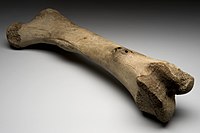
Photo from wikipedia
I have read the article entitled ‘‘European status on temporal bone training: a questionnaire study’’, published by Frithioff et al. [1], with interest and admiration. The authors develop a very… Click to show full abstract
I have read the article entitled ‘‘European status on temporal bone training: a questionnaire study’’, published by Frithioff et al. [1], with interest and admiration. The authors develop a very relevant reflection about surgical competency and training, surgical outcomes and patient safety, a propos of the decreasing availability of cadaveric material and of the need to consider alternatives for temporal bone surgery training, like synthetic models and virtual reality. I am the Head of the Department of Otorhinolaryngology of a tertiary referral and university centre at Lisbon, Portugal. Temporal bone training is quite well established in several centres in this country, a country that was not signalled in the European map presented in the commented article. The length of the ORL residency training in Portugal is 5 years. In my department, a dissection laboratory is permanently available, and temporal bones are available for training since the first year of residency and also for seniors. We obtain temporal bones for training, as approved by national law regulating the dissection of cadavers and extraction of its parts. Portugal has a favourable legislation for medical education, because extraction of specimens for teaching is allowed provided that the person has not manifested his opposition in life. Other European and non-European countries have a less favourable legislation for medical education, because persons should have to consent positively during life. We do not have artificial models for our trainees because they are expensive. We completed the 40th edition of the Temporal Bone Dissection Course in October 2017. We provide three fresh (frozen) temporal bones per participant along the 5-day course. I completely agree with Frithioff et al. in questioning the traditional “see one, do one, teach one” paradigm for surgical education nowadays, because of concerns about safety and quality, and I plan surgical education based on the more updated framework: “learn, see, practice, prove, do, and maintain” [2]. In my opinion, simulation and artificial models can be an alternative to the initial approach for temporal bone surgical training and to develop a basic level of competencies but are not adequate to the mastery learning or to prove performance. Temporal bones can do it, because they are the perfect near-real reality model, and offer the inexhaustible and non-reproducible variability of the temporal bone anatomy for training. After dissecting more than 150 temporal bones in the last 25 years, I am always surprised by the new and individual findings in each particular specimen I use for training. The idea that I want to add to the discussion of this topic, and the appeal that I want to make for those who lead surgical training, medical education and our specialty is this: do not accept the poor availability of temporal bones or other cadaver specimens as inevitable. Temporal bones are more needed now than ever for training competencies and to maintain performance. Sadly, we verify that a growing market of specimens obtained thought private supply companies supplant less available specimens obtained by free donations, which we should strongly question. In this ever-changing word, medical education should strive firmly and ethically for the best conditions to address the challenging demands, interests and values of the present patients and society. Law and regulations should serve society and the best interests of each of us and all. We, otorhinolaryngologists, individually and as a whole, should undertake all the efforts to educate, engage and gain support of the patients, medical education leaders, journalists, policymakers, legislators, and the whole society on the need of cadaver specimens for surgical training, for the best interests of the patients and of the society. * Pedro Alberto Escada [email protected]
Journal Title: European Archives of Oto-Rhino-Laryngology
Year Published: 2018
Link to full text (if available)
Share on Social Media: Sign Up to like & get
recommendations!